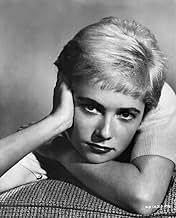A doomed female hitchhiker pulls Mike Hammer into a deadly whirlpool of intrigue, revolving around a mysterious "great whatsit".A doomed female hitchhiker pulls Mike Hammer into a deadly whirlpool of intrigue, revolving around a mysterious "great whatsit".A doomed female hitchhiker pulls Mike Hammer into a deadly whirlpool of intrigue, revolving around a mysterious "great whatsit".
- Awards
- 1 win & 1 nomination total
Marian Carr
- Friday
- (as Marion Carr)
Mady Comfort
- Nightclub Singer
- (as Madi Comfort)
- Director
- Writers
- All cast & crew
- Production, box office & more at IMDbPro
Storyline
Did you know
- TriviaThe Kefauver Commission, a federal unit dedicated to investigating corrupting influences in the 1950s, singled this out as 1955's number one menace to American youth. Because of this, Robert Aldrich felt compelled to conduct a writing campaign for the free speech rights of independent filmmakers.
- GoofsAt the beginning, Christina (Cloris Leachman) is shown running at the side of the highway, but the shots of only her feet show her running along the painted center line of the highway.
- Quotes
Mike Hammer: You're never around when I need you.
Velda: You never need me when I'm around.
- Crazy creditsThe opening credits scroll down instead of the usual up, resulting in needing to read them bottom to top.
- Alternate versionsUntil 1997, all known copies in circulation of "Kiss Me Deadly" ended rather abruptly: the wounded Mike Hammer stumbling through the beach house looking for his partner Velda, and then there's a couple of brief shots of the house exploding and burning, with "The End" superimposed on the final shot. The music is cut off instead of fading out, and the screen turns black; it looks like Mike and Velda died in the blaze.
- ConnectionsEdited into American Cinema: Film Noir (1995)
- SoundtracksRather Have the Blues
Sung by Nat 'King' Cole
Written by Frank De Vol (uncredited)
[Played on the car radio during the opening title card and credits]
Featured review
Robert Aldrich was a no-nonsense film director. When he undertook the direction of this film, little did he know it was going to become the extraordinary movie it turned out to be. The fame seems to have come by its discovery in France, as it usually is the case. Based on Mickey Spillane's novel and adapted by Al Bezzerides, the movie has an unique style and it's recommended viewing for fans of the film noir genre.
Right from the start, the film gets our imagination as we watch a young woman running along a California highway. That sequence proved Mr. Aldrich's ability to convey the idea of a disturbed young woman that seems to have escaped from a mental institution. The plot complicates itself as Hammer learns that Christine, the young woman, has died. He decides to investigate, which is what he does best.
Some excellent comments have been submitted to this forum, so we will not even try to expand in the action but will only emphasize in the tremendous visual style Mr. Aldrich added to the film, which seems to be its main attraction. For a fifty year old film, it still has a crisp look to it thanks to the impressive black and white cinematography of Ernest Lazlo, who had a keen eye to show us Hammer's world as he makes it come alive. The great musical score by Frank DeVol fits perfectly with the atmosphere of the L.A. of the fifties.
Ralph Meeker made an excellent contribution as Mike Hammer. He dominates the film with his presence. Albert Decker, Paul Stewart, Miriam Carr, Maxine Cooper, Fortuno Bonanova, and especially Cloris Leachman, in her screen debut, make this film the favorite it has become.
Fans of the genre can thank Mr. Aldrich for making a film that didn't pretend to be anything, yet has stayed as a favorite all these years.
Right from the start, the film gets our imagination as we watch a young woman running along a California highway. That sequence proved Mr. Aldrich's ability to convey the idea of a disturbed young woman that seems to have escaped from a mental institution. The plot complicates itself as Hammer learns that Christine, the young woman, has died. He decides to investigate, which is what he does best.
Some excellent comments have been submitted to this forum, so we will not even try to expand in the action but will only emphasize in the tremendous visual style Mr. Aldrich added to the film, which seems to be its main attraction. For a fifty year old film, it still has a crisp look to it thanks to the impressive black and white cinematography of Ernest Lazlo, who had a keen eye to show us Hammer's world as he makes it come alive. The great musical score by Frank DeVol fits perfectly with the atmosphere of the L.A. of the fifties.
Ralph Meeker made an excellent contribution as Mike Hammer. He dominates the film with his presence. Albert Decker, Paul Stewart, Miriam Carr, Maxine Cooper, Fortuno Bonanova, and especially Cloris Leachman, in her screen debut, make this film the favorite it has become.
Fans of the genre can thank Mr. Aldrich for making a film that didn't pretend to be anything, yet has stayed as a favorite all these years.
Details
- Release date
- Country of origin
- Languages
- Also known as
- Mickey Spillane's Kiss Me Deadly
- Filming locations
- Clay Street, Bunker Hill, Downtown, Los Angeles, California, USA(Mike parks his Corvette and takes the back steps up to the Hillcrest Hotel)
- Production company
- See more company credits at IMDbPro
Box office
- Budget
- $410,000 (estimated)
- Gross US & Canada
- $726,000
- Gross worldwide
- $952,000
- Runtime1 hour 46 minutes
- Color
- Aspect ratio
- 1.85 : 1
Contribute to this page
Suggest an edit or add missing content






































